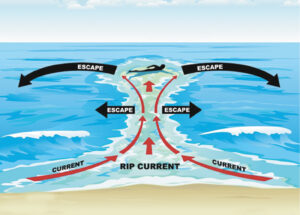 Outdoor family gatherings and activities bring us closer together, but statistics show that heat, floods, lightning, boating, swimming accidents and fireworks can change lives instantly.
Outdoor family gatherings and activities bring us closer together, but statistics show that heat, floods, lightning, boating, swimming accidents and fireworks can change lives instantly.
Pay attention to your surroundings during all that fun under the sun so you will have a summer to remember and cherish.
Going Outdoors: Heat, Dehydration, and Sun Safety
Extreme Florida heat can be lethal, causing illness, dehydration, and even death.
• Stay hydrated by drinking plenty of fluids. The sun works fast and has no mercy. Avoid drinks with caffeine or alcohol. Encourage guests and family members to drink lots of water at gatherings. Remember that ultraviolet (UV) rays bounce off sand, concrete, and water.
• Sunscreen, sunscreen, and more sunscreen – for all members of the family, especially infants and children and the elderly. Apply and reapply often. Use at least 30 SPF to protect your skin.
• Sensitive to sunburn? Wear a hat and try to stay in the shade.
• Remember: If your urine is yellow or dark yellow, you are likely dehydrated and need to drink more water.
• Wear loose-fitting, lightweight, light-colored clothing. Avoid dark colors because they absorb the sun’s rays.
• Slow down, stay indoors and avoid strenuous exercise during the hottest part of the day.
• Postpone outdoor games and activities.
Sun Protection Tips
As temperatures begin reaching well into the 90s, remember to apply sunscreen, limit your exposure to the sun, and protect your eyes with sunglasses.
• Use a broad-spectrum sunscreen with an SPF of 30 or higher.
• Wear clothing and a wide-brimmed hat to protect as much skin as possible.
• Seek shade when possible, and remember that the sun’s ultraviolet rays are strongest between 10 a.m.-4 p.m.
Lightning Safety
• Hear thunder? Move your feet! Most people are struck by lightning before it starts raining or after it stops raining. Don’t stay outside just
because the rain hasn’t come down yet. As the National Weather Service advises: “When it roars, go indoors.”
– Find a safe, enclosed shelter such as a home, office, shopping center, or hard-top vehicle with the windows rolled up.
– Be aware. Check the weather forecast before participating in outdoor activities. If the forecast calls for thunderstorms, postpone your event or make sure adequate safe shelter is readily available.
• Caught in the open? Leave elevated areas such as hills, mountain ridges, or peaks.
– Never lie flat on the ground. Crouch down in a ball-like position with your head tucked and hands over your ears so that you are down low with minimal contact with the ground.
– Never shelter under an isolated tree.
– Immediately get out of and away from ponds, lakes, and other bodies of water.
– Stay away from objects that conduct electricity (barbed wire fences, power lines, etc.).
Water Safety is Everyone’s Responsibility
Drowning is 100 percent preventable! And drowning happens quickly and quietly. Unless rescued, a drowning person will last only 20 to 60 seconds before submerging, reports the Red Cross.
Rule No. 1: Never swim alone!
• Watch kids when they are in or around water without being distracted. Keep young children within arm’s reach of an adult. Make sure older children swim with a partner.
• Close toilet lids and use toilet seat locks to prevent drowning. Keep doors to bathrooms and laundry rooms closed.
• Teach children how to swim. Every child is different, so enroll children in swim lessons when they are ready. Consider their age, development, and how often they are around water.
What if you’re caught in a rip current?
• Relax, rip currents don’t pull you under.
• Don’t swim against the current. You may be able to escape by swimming out of the current in a direction following the shoreline or toward breaking waves, then at an angle toward the beach.
• You may be able to escape by floating or treading water if the current circulates back toward shore.
• If you feel you will be unable to reach shore, draw attention to yourself. If you need help, yell and wave for assistance.
Boating Safety
Your children should always wear a life jacket when playing water sports and while on any type of watercraft, around open bodies of water, and even while on docks. Make sure the life jackets are approved by the U. S. Coast Guard.
Other helpful boating safety tips:
• Explain some basic rules and have everyone follow them.
• Enroll older kids in a boating safety course. Better yet, enroll with them.
• Get a free safety check every year from the U. S. Coast Guard Auxiliary for U. S. Power Squadrons. Find a location.
• Just like on the road, have a designated driver for the boat.
• In many states, no one under 14 years of age may operate any personal watercraft at any time, even if such a person possesses a Boating Safety Education ID Card.







